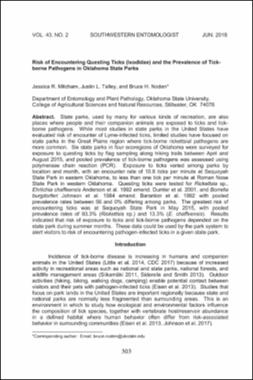| dc.contributor.author | Mitcham, Jessica R. | |
| dc.contributor.author | Talley, Justin L. | |
| dc.contributor.author | Noden, Bruce H. | |
| dc.date.accessioned | 2022-04-12T13:44:35Z | |
| dc.date.available | 2022-04-12T13:44:35Z | |
| dc.date.issued | 2018-06 | |
| dc.identifier | oksd_noden_riskofencountering_2018 | |
| dc.identifier.citation | Mitcham, J. R., Talley, J. L., & Noden, B. H. (2018). Risk of encountering questing ticks (Ixodidae) and the prevalence of tickborne pathogens in Oklahoma state parks. Southwestern Entomologist, 43(2), pp. 303-315. https://doi.org/10.3958/059.043.0202 | |
| dc.identifier.uri | https://hdl.handle.net/11244/335143 | |
| dc.description.abstract | State parks, used by many for various kinds of recreation, are also places where people and their companion animals are exposed to ticks and tickborne pathogens. While most studies in state parks in the United States have evaluated risk of encounter of Lyme-infected ticks, limited studies have focused on state parks in the Great Plains region where tick-borne rickettsial pathogens are more common. Six state parks in four ecoregions of Oklahoma were surveyed for exposure to questing ticks by flag sampling along hiking trails between April and August 2015, and pooled prevalence of tick-borne pathogens was assessed using polymerase chain reaction (PCR). Exposure to ticks varied among parks by location and month, with an encounter rate of 10.8 ticks per minute at Sequoyah State Park in eastern Oklahoma, to less than one tick per minute at Roman Nose State Park in western Oklahoma. Questing ticks were tested for Rickettsia sp., Ehrlichia chaffeensis Anderson et al. 1992 emend. Dumler et al. 2001, and Borrelia burgdorferi Johnson et al. 1984 emend. Baranton et al. 1992 with pooled prevalence rates between 56 and 0% differing among parks. The greatest risk of encountering ticks was at Sequoyah State Park in May 2015, with pooled prevalence rates of 93.3% (Rickettsia sp.) and 13.3% (E. chaffeensis). Results indicated that risk of exposure to ticks and tick-borne pathogens depended on the state park during summer months. These data could be used by the park system to alert visitors to risk of encountering pathogen-infected ticks in a given state park. | |
| dc.format | application/pdf | |
| dc.language | en_US | |
| dc.publisher | Society of Southwestern Entomologists | |
| dc.relation.ispartof | Southwestern Entomologist, 43 (2) | |
| dc.rights | This material has been previously published. In the Oklahoma State University Library's institutional repository this version is made available through the open access principles and the terms of agreement/consent between the author(s) and the publisher. The permission policy on the use, reproduction or distribution of the material falls under fair use for educational, scholarship, and research purposes. Contact Digital Resources and Discovery Services at lib-dls@okstate.edu or 405-744-9161 for further information. | |
| dc.title | Risk of encountering questing ticks (Ixodidae) and the prevalence of tickborne pathogens in Oklahoma state parks | |
| dc.date.updated | 2022-04-07T14:13:28Z | |
| osu.filename | oksd_noden_riskofencountering_2018.pdf | |
| dc.description.peerreview | Peer reviewed | |
| dc.identifier.doi | 10.3958/059.043.0202 | |
| dc.description.department | Entomology and Plant Pathology | |
| dc.type.genre | Article | |
| dc.type.material | Text | |
| dc.subject.keywords | Prevention | |
| dc.subject.keywords | Vaccine Related | |
| dc.subject.keywords | Infectious Diseases | |
| dc.subject.keywords | Emerging Infectious Diseases | |
| dc.subject.keywords | Vector-Borne Diseases | |
| dc.subject.keywords | 0608 Zoology | |
| dc.subject.keywords | Entomology | |
| dc.identifier.author | ScopusID: 56585847400 (Mitcham, JR) | |
| dc.identifier.author | ORCID: 0000-0002-2932-1866 (Talley, JL) | |
| dc.identifier.author | ScopusID: 55168292000 (Talley, JL) | |
| dc.identifier.author | ORCID: 0000-0002-0096-370X (Noden, BH) | |
| dc.identifier.author | ScopusID: 6601968347 (Noden, BH) | |
